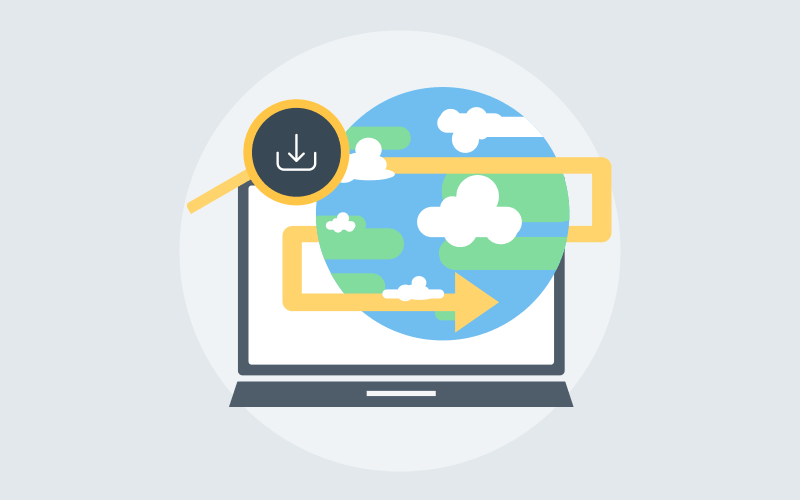
SCORM is key to ensuring that eLearning content and learning management systems (LMS) work well together. It enables interoperability between different software products and allows content to be easily shared and used across different systems without modification.
This makes it a powerful technology in the realm of eLearning and online training.
If you’re new to SCORM and how it works, we’re here to help you.
In this blog post, we’ll be answering all the questions related to this technical specification. Plus, we will look at the top SCORM-compliant LMS you can use.
What Is SCORM?
To start with, let’s define SCORM.
For those of you wondering what the meaning of SCORM is or what SCORM stands for, it’s an acronym for “Sharable Content Object Reference Model”. It’s a set of technical standards developed for supporting eLearning tools, ensuring they play well with each other.
This is significant because top companies use 37 different software tools on average to run their day-to-day business operations, according to the enterprise software discovery platform Siftery.
It would be difficult without a means to communicate between these tools. It would be akin to a group of people working together towards a common goal but not talking to each other at all.
SCORM ensures interoperability between such online learning software and saves users from the pain of disconnected systems.
This model determines how eLearning content and an LMS communicate.
Watch: What Is SCORM & How Does It Work?
How Does SCORM Work?
SCORM governs two things: content packaging and runtime data exchange.
Let’s elaborate on it.
Content packaging, also known as the content aggregation model, is how you deliver a piece of content. For this, SCORM uses a file called “imsmanifest”, which contains all the information an LMS requires to import and launch content.
This file also contains XML, which determines the structure of a course from the perspective of learners and a physical file system. It answers questions such as, “What is the name of this content?” and “Which document should be launched?”
On the other hand, runtime data exchange or communication specifies how the content ”talks” to the LMS. It’s made up of two components:
- First, the content has to “discover” the LMS. Once it finds the LMS, it can then communicate a series of messages, such as “request the learner’s name” and “inform the LMS that the learner scored 85% on this test.”
- Based on this vocabulary, SCORM communicates rich interactive experiences to an LMS.
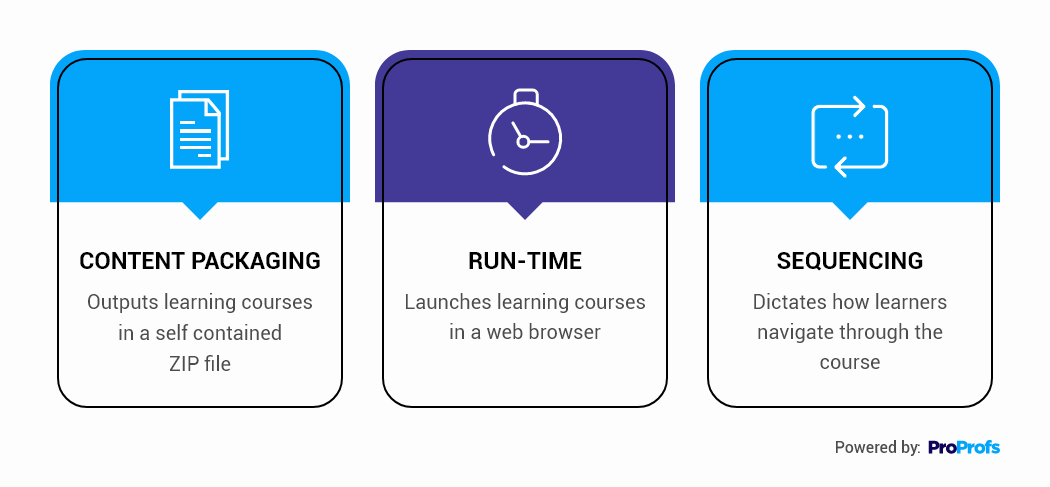
Why Use SCORM?
For many people who are new to the technology, to SCORM or not to SCORM is a big question.
So, should they go ahead and adopt SCORM?
Preferably yes.
SCORM is the de facto standard for software interoperability. It can help you in your online learning programs. SCORM compliance can make eLearning seamless.
You should use it if you want to:
- deploy courses that work on multiple platforms
- offer more interactive experiences to your learners
- track user data related to courses and tests
- simplify how you migrate content from one LMS to another
Benefits of Using SCORM
There are many benefits of SCORM API. Anyone engaged in online training or eLearning can take advantage of them.
Some of the top ones worth mentioning here are:
- Content creation and deployment become much easier with SCORM
- It ensures improved flexibility in selecting and switching tools
- Seamless interaction between online content and LMS
- You can tailor content to the needs of every user without re-coding
- A sophisticated delivery mechanism to reach out to more learners at one time
- Course authoring tools and LMS can sync and work in close collaboration
- SCORM is durable and it can withstand technology disruptions
How to Create a SCORM Course
If you’re new to SCORM, you may have additional questions like: What is a SCORM file and how to create a SCORM file?
A SCORM file is a type of file that has been packaged according to the requirements of SCORM standards. You can deploy such files across all SCORM-compliant LMS.
Let’s now look at some of the best practices for creating SCORM courses.
Use an Authoring Tool & SCORM LMS
According to SCORM developer Rustici Software LLC, the best way to create SCORM courses is to use an authoring tool. If you plan to use your courses in an LMS, make sure that the LMS supports SCORM so that the content is compatible with the LMS.
Look for an Integrated LMS
Most of the authoring tools available today come integrated with LMS software. This means there’s no need to purchase a standalone solution to convert presentations to SCORM. Not only that, these tools provide great functionality, so building professional-looking courses is easy.
Upload Courses to an Online Learning System
These authoring tools automatically generate the code necessary for interaction with an LMS and turn all the eLearning material into SCORM packages. You just need to upload the course to your online learning system.
To learn how to upload a SCORM course to your LMS, check out this guide.
Keep Rustici Driver in Mind
Make sure the authoring tool you choose is based on Rustici Driver (formerly SCORM Driver). The content should support SCORM and other standards and be published according to SCORM standards.
Examples include eLearning and training tools such as ProProfs Training Maker, which fully supports courses based on Rustici Driver.
As you can see, creating a SCORM course involves several steps. First, design your e-learning content using authoring tools like ProProfs Training Maker, ensuring it follows SCORM guidelines. Then, export the content as a SCORM package (commonly a zip file). Ensure your content is structured with manifest files (imsmanifest.xml) and adheres to SCORM metadata standards.
Upload the SCORM package to your LMS for testing and deployment. Test the content’s functionality and tracking capabilities within the LMS to ensure proper data communication between the content and the LMS for learner tracking and reporting.
Watch: How to Create an Online Course from Scratch?
SCORM Versions
Currently, there are five versions of SCORM:
- SCORM 1.1
- SCORM 1.2
- SCORM 2004 2nd Edition
- SCORM 2004 3rd Edition
- SCORM 2004 4th edition
Which versions you should use really depends on what you want from your content.
SCORM 1.2 and SCORM 2004 3rd Edition are the most widely used among these versions.
For more detail on the SCORM versions, including a timeline of their evolution, check this SCORM versions comparison chart.
SCORM Adoption Case Study
Who: Leon Medical Centers, Miami’s leading healthcare services provider serving Medicare patients since 1996.
Learning Need: Leon Medical Centers needed an enterprise LMS that supports SCORM standards and lets trainers create their own courses.
The healthcare services provider planned to integrate the system into its HRIS for ease of data export.
Solution: It found these solutions in ProProfs’ SCORM and TinCan API (xAPI)-compliant LMS. It benefited from its ease of use and flexibility.
Results: The flexibility to create custom content, access pre-built SCORM or Tin Can content, and find all the training in a hub are some of the benefits Leon Medical Centers could realize from the platform.
Read the full story.
List of SCORM-Compliant LMS
We have shortlisted the 10 best SCORM-compliant LMS below based on our experience, reviews in software comparison sites, and in-depth research. These top picks will certainly meet your SCORM learning needs.
1. ProProfs Training Maker – Best for Recording Learning Experiences
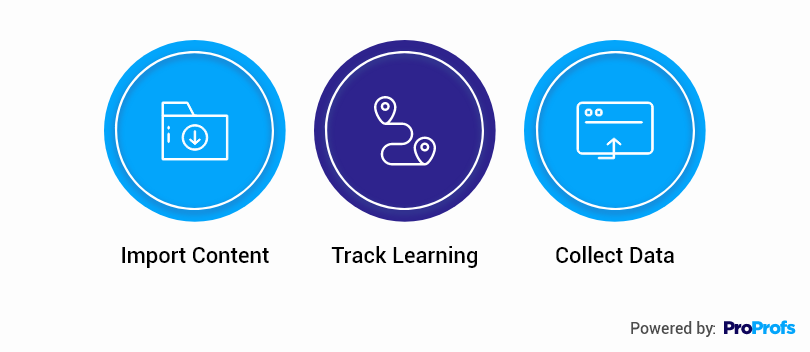
As a cloud-based LMS, ProProfs Training Maker simplifies creating, managing, delivering, tracking, and analyzing online courses. With its SCORM compliance, you can effortlessly import content from various eLearning tools and centralize all course materials.
Additionally, the ability to record learners’ interactions is a vital aspect of tracking their progress. With the SCORM LMS, you can keep track of detailed user activity, identify who has completed the courses, and pinpoint areas where learners may need improvement.
This ensures course compliance, helps assess course quality, and enables you to make necessary improvements.
ProProfs Training Maker integrates with a SCORM-compliant Learning Record Store (LRS), which is immensely helpful in collecting and analyzing learning data.
Having all the data in one central location simplifies tracking learner reports and eliminates the need for multiple tools. The seamless integration with the LRS enhances the overall efficiency and effectiveness of training.
What You Will Like:
- Import materials from other eLearning tools to save time and effort
- Ensure course compliance by creating courses with specific learning objectives
- Issue training certificates to motivate participants
- Cross-device compatibility for uninterrupted learning experiences
Why You May Not Like:
- A limited number of course templates
- The free plan supports only up to 10 learners
Pricing:
Forever free for up to 10 learners. Paid plans start at $1.97 /active learner/month. No hidden charges. 15-day money-back guarantee.
Watch: How to Upload SCORM Courses to ProProfs Training Maker
2. Docebo – Best for Automated Learning
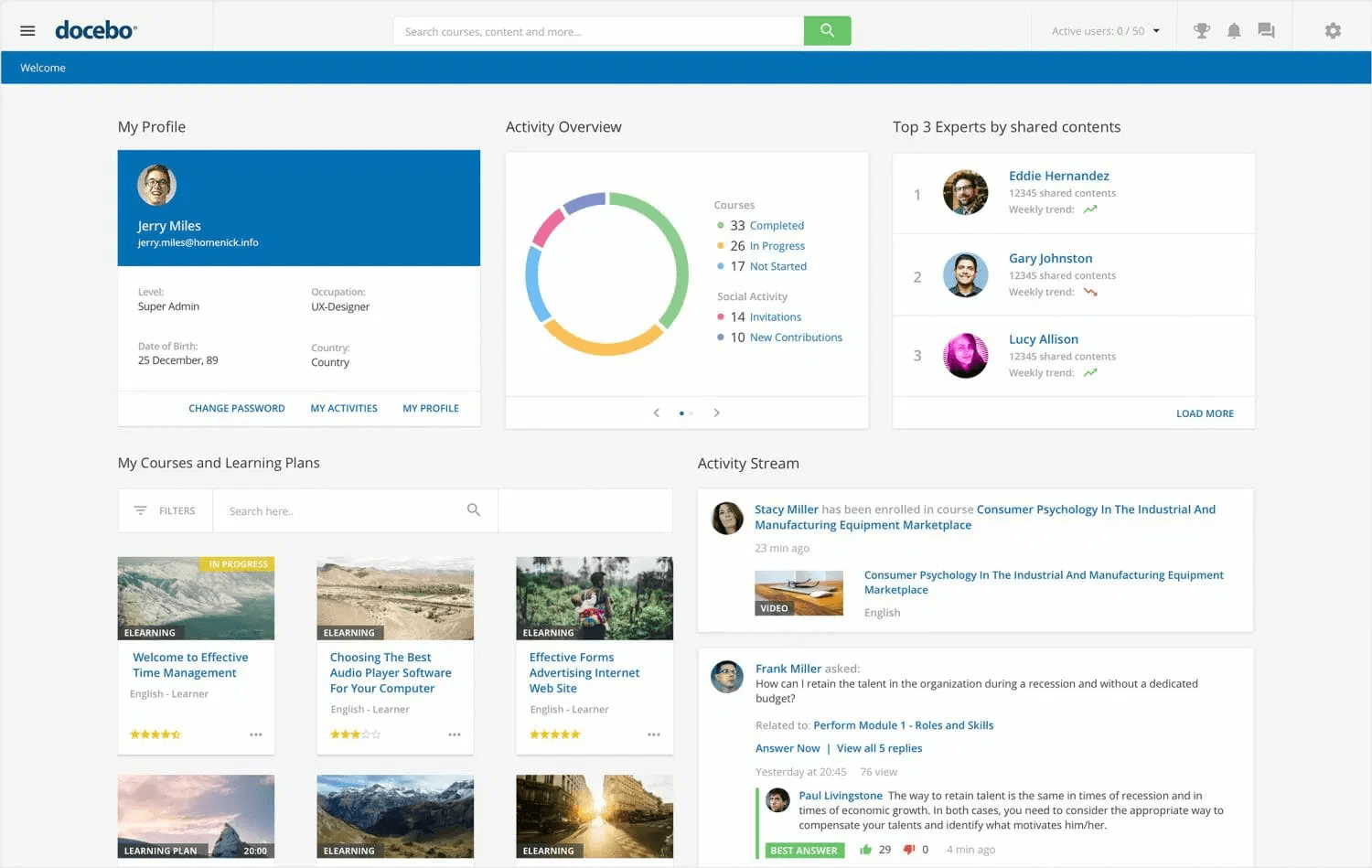
Docebo is marked by an intuitive design and layout. This SCORM LMS integrates with SCORM content, making importing, managing, and delivering SCORM-based courses effortless.
This compatibility opened up a world of possibilities, as you can leverage a vast library of pre-existing SCORM content and create your interactive modules.
One of the key reasons to consider Docebo is its exceptional automation capabilities. Docebo excels in automating various aspects of the learning process and saving valuable time and effort.
You can set up automated course enrollments, notifications, and reminders to ensure that learners stay engaged and informed without constant manual intervention.
What You Will Like:
- Intuitive UI that makes it easy for both administrators and learners to navigate
- It’s highly scalable and can accommodate the needs of growing organizations
- Mobile-friendly tool to access training materials from anywhere
- Enables you to create learning paths for guided learning
What You May Not Like:
- Initial setup and configuration can be time-consuming
- Limited reporting options may hinder in-depth analysis
Pricing:
Starts at $25,000/year. Free trial available.
3. LearnUpon – Best for SMEs
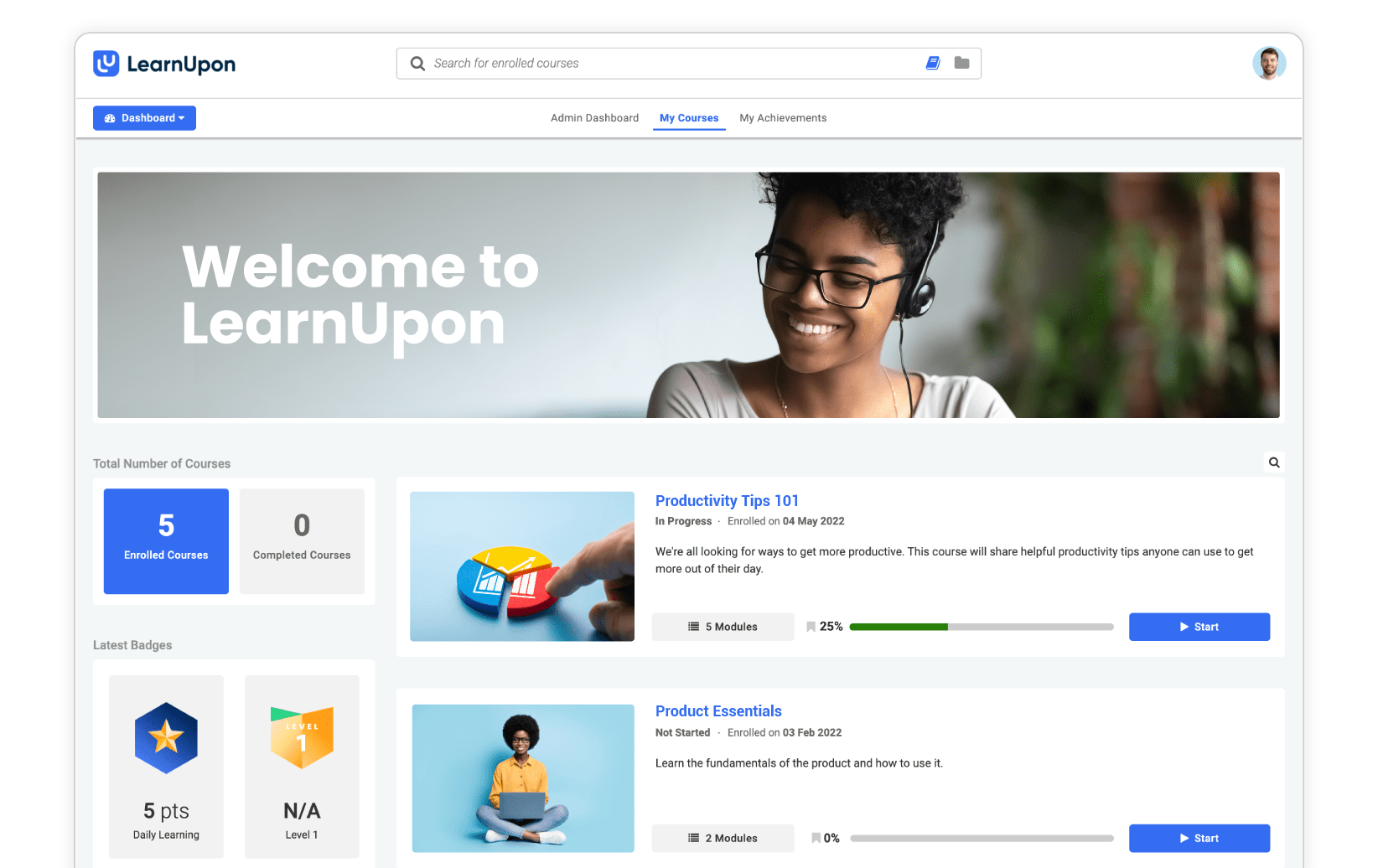
LearnUpon is another SCORM LMS with an exceptionally user-friendly interface. You can easily navigate the platform and manage and deliver training content effortlessly.
Its incredible flexibility and customization options allow users to create interactive and visually appealing courses that captivate learners.
The seamless SCORM compliance ensures that content is compatible across different devices and platforms, ensuring a consistent learning experience.
Similarly, the robust reporting and analytics capabilities are like a treasure trove of information, empowering users to fine-tune training programs based on real-time insights.
Moreover, LearnUpon’s affordability is a big plus for SMEs as it provides top-notch features without breaking the bank.
What You Will Like:
- A robust content library management feature for organizing training materials
- Gamification features for learner engagement
- Multilingual support to accommodate learners from various regions
- Facilitates seamless integration with third-party tools
What You May Not Like:
- Options for creating assessments or adaptive quizzes are somewhat limited
- Trainers with limited IT infrastructure may experience performance issues
Pricing:
Starts at $599/month. 50 active users.
4. Litmos – Best for Social Learning
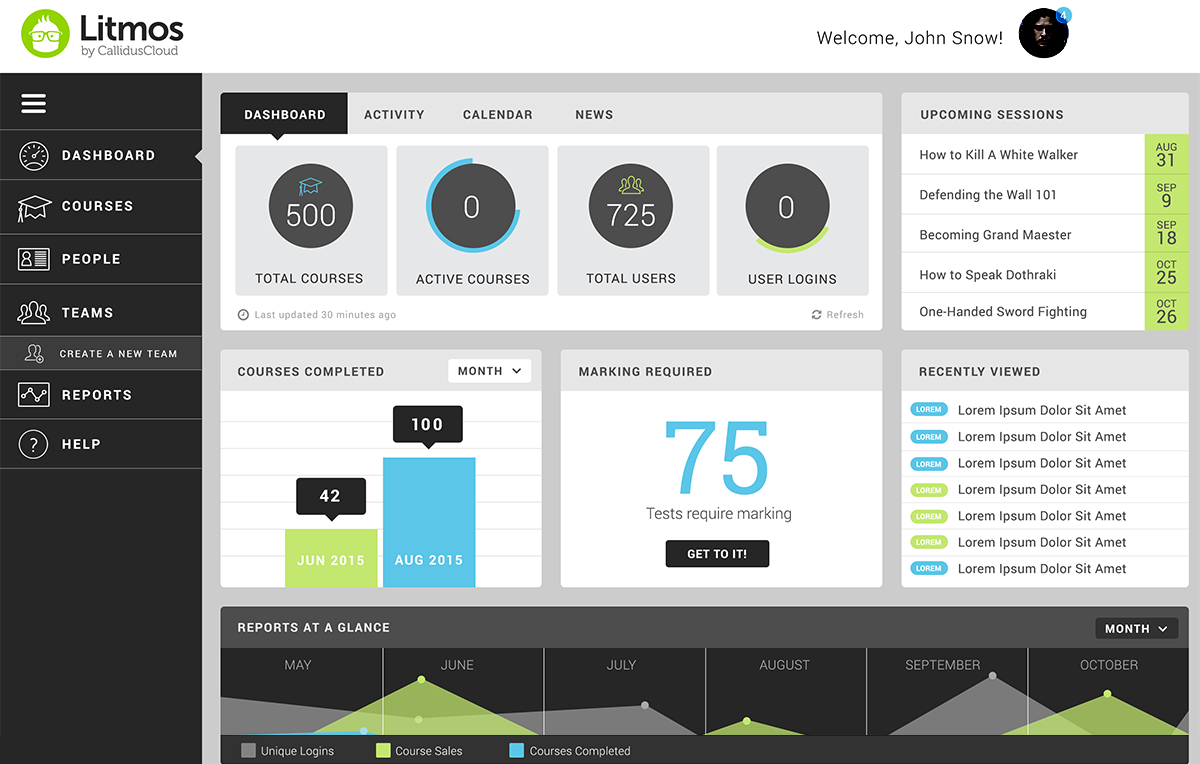
We found Litmos to be another superior solution, especially for social learning.
Its seamless integration with SCORM content allowed users to design interactive and engaging courses easily. You can implement social learning initiatives for multiple teams.
With Litmos, you can create SCORM-compliant modules that include discussion boards, collaborative projects, and virtual classrooms. The ability to track learners’ progress, completion rates, and SCORM data within the platform provides valuable insights for continuous improvement.
By incorporating SCORM elements into your social learning strategy, you can witness increased learner engagement, knowledge retention, and a stronger sense of community among the participants.
What You Will Like:
- Rich mobile capabilities for access from anywhere
- Strong tracking metrics to see real-time performance
- Supports engaging and interactive content
- Ability to string courses together into learning paths
What You May Not Like:
- Occasional glitches in recording course completion
- No support for taking courses offline (but supposedly coming soon)
Pricing:
Starts at $6/user/month for small companies or departments.
5. iSpring Learn – Best for Corporate Training
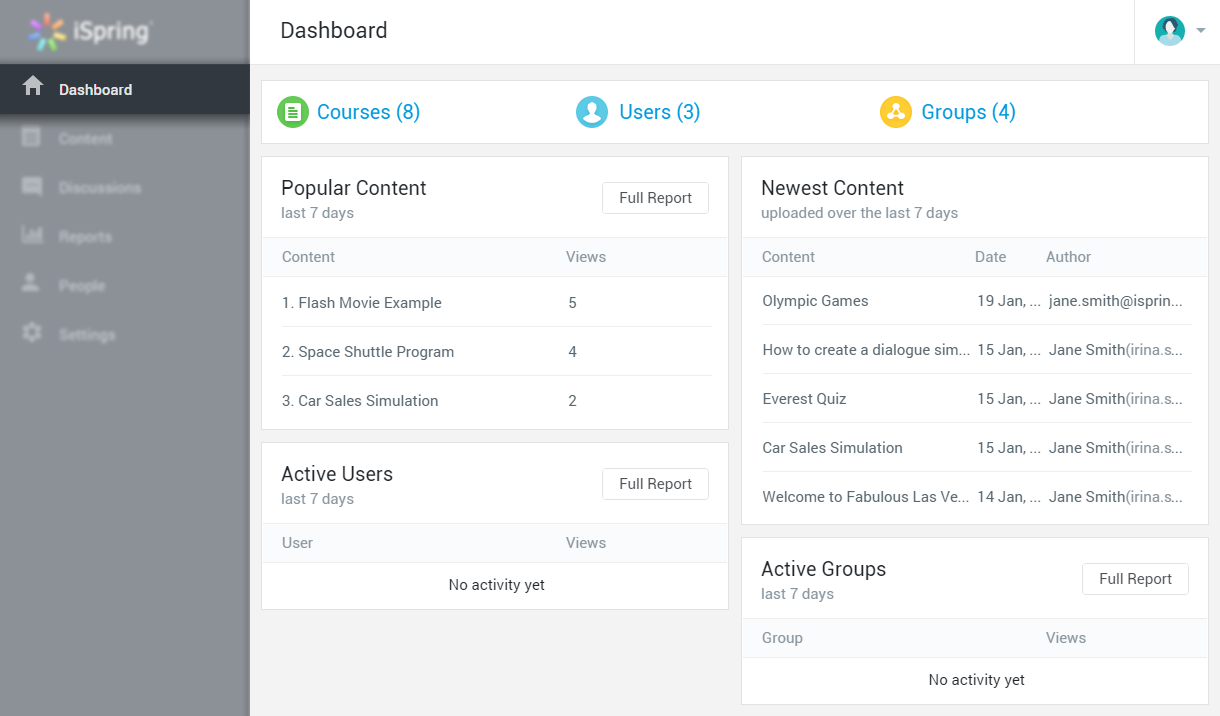
iSpring Learn is one of the best SCORM-compliant LMS for corporate training. Its extensive features and intuitive interface make it ideal for successful training initiatives.
iSpring Learn is excellent for content management. It supports easy uploading and creating various content types, including presentations, courses, video tutorials, and audio tracks. Its SCORM support ensures seamless registration and tracking of SCORM 1.2 and SCORM 2004 content.
The tool offers unlimited storage space, enabling organizations to manage a vast amount of content without restrictions. It also allows the creation of interactive longreads within the LMS, making learning materials engaging and visually appealing.
With robust user management capabilities, iSpring Learn can simplify an organization’s structure, user invitations, role assignments, and group creation. Learning tracks can be built by combining courses and materials, providing a structured learning experience.
What You Will Like:
- Supports multimedia like videos and simulations for an immersive learning experience
- Compatible with mobile devices to enable learning on the go
- Detailed analytics to get valuable insights into learner engagement
- Powerful integration for seamless content creation, management, and collaboration
What You May Not Like:
- Not suitable for diverse audiences as it offers limited language support
- Need more self-explanatory articles and guides to understand the platform better
Pricing:
Starts at $2.29/user/month (billed annually).
6. Bridge – Best for Simplified Learning

Bridge is a SCORM-compliant LMS recommended for simplified learning. The platform’s robust features enable effortless content creation, delivery, and assessment, streamlining the learning process.
Bridge ensures engagement and effective learning outcomes, from interactive quizzes to real-time progress tracking.
The LMS seamlessly integrates SCORM courses and enables users to take advantage of interactive and engaging content provided by various content creators.
In addition, its responsive mobile app facilitates learning on the go.
This tool has revolutionized eLearning, making it indispensable for anyone who wants to enhance the learning experience.
What You Will Like:
- Bridge accepts raw SCORM data and provides detailed learner interaction reports
- The interface is user-friendly and easy to navigate
- Facilitates quick registration for live training sessions
- Simplifies the process of assigning learning paths for targeted learning
What You May Not Like:
- Lacks text editing options in the internal authoring tool
- Inconsistent speed of operation, sometimes fast, other times slow and clunky
Pricing:
Starts at $4/user/month. Billed annually.
7. Tovuti – Best for Learner Engagement
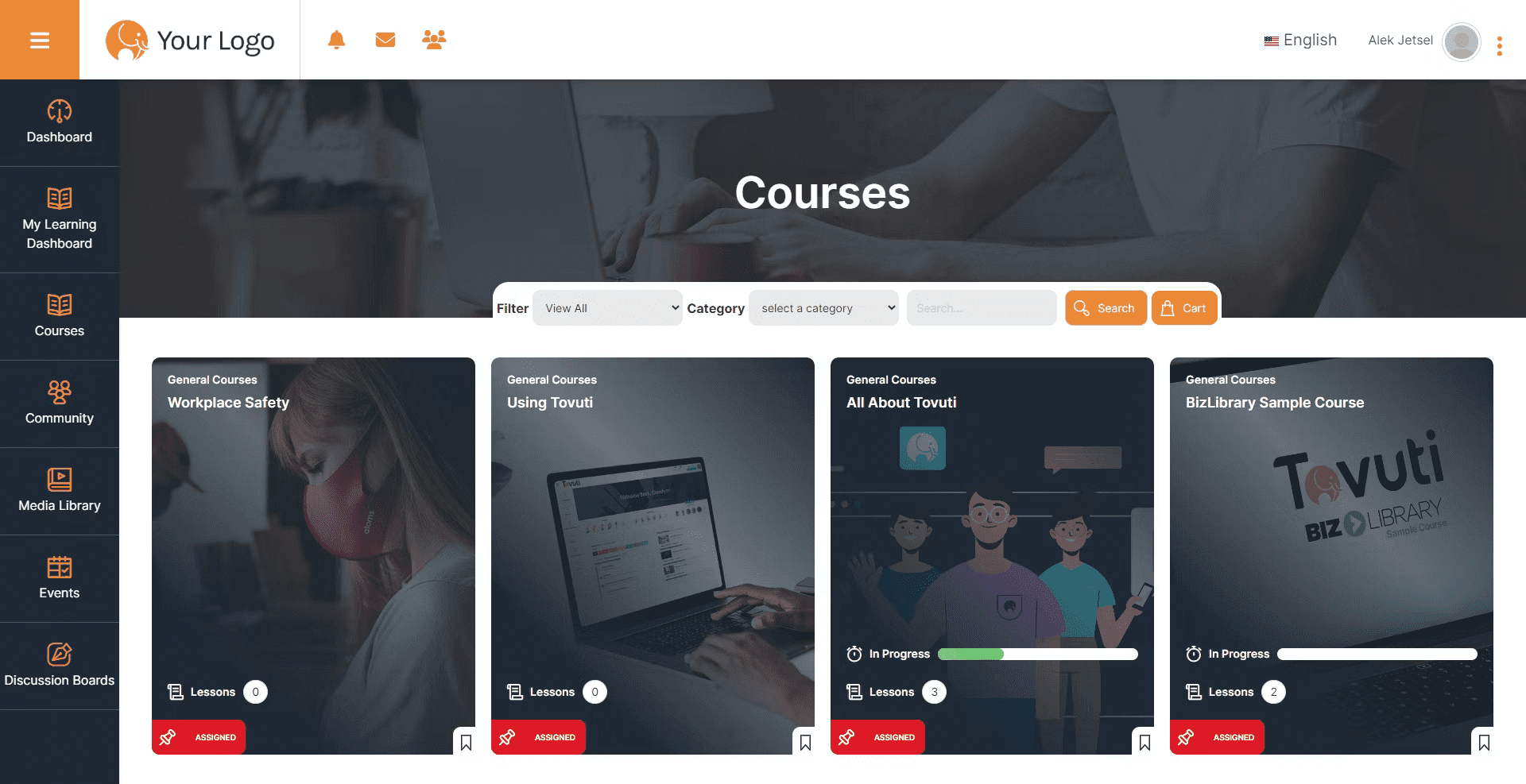
Tovuti is a SCORM LMS noted for its ability to promote learner engagement.
It can significantly enhance your interactions with learners. Effortlessly create and deliver captivating SCORM courses to keep your participants motivated and eager to learn.
With Tovuti’s innovative features and interactive learning tools, it’s easy to design dynamic assessments, quizzes, and multimedia content that challenge and excite learners.
Whether conducting live training sessions, hosting webinars, or offering self-paced courses, Tovuti empowers you to create a vibrant learning environment that fosters collaboration and knowledge-sharing.
What You Will Like:
- Detailed reporting (gives a clear picture of learner progress)
- Easy to set up and manage registered courses
- Suitable for all sizes of organizations
- Supports microlearning for better knowledge retention
What You May Not Like:
- No dedicated Windows app, must use it via a web browser
- No font style selection in Columns mode
Pricing:
Starts at $11,160/year (Billed annually). Up to 50 users.
8. Absorb LMS – Best for Training Large Teams
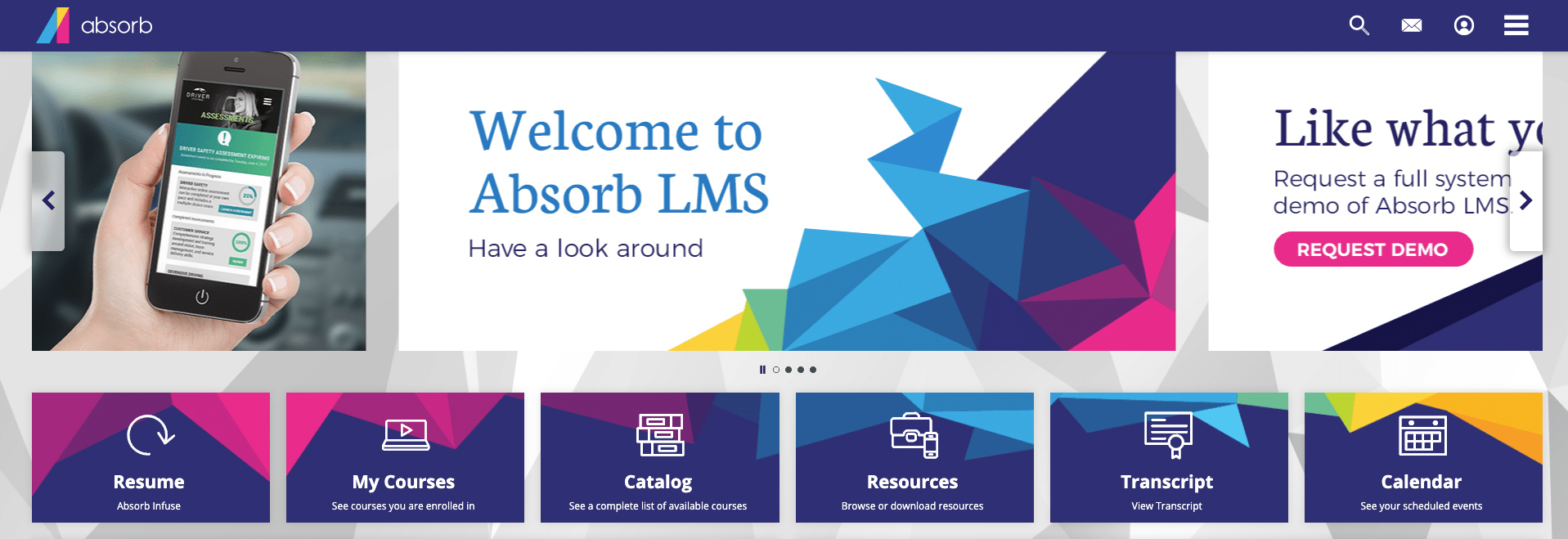
If you’re responsible for training large teams, you can consider Absorb LMS. The platform’s smart administration tools make managing and organizing training programs at scale a breeze.
Learner engagement is taken to another level with interactive and gamified content through Absorb Engage. The detailed reporting and analytics offered by Absorb Analyze can help you gain valuable insights into your training efforts. Absorb LMS is fully SCORM compliant, and it makes integrating existing courses effortless.
The mobile app enables users to access training anytime, anywhere.
Moreover, Absorb Pinpoint’s AI-driven personalization ensures each learner gets a tailored experience.
Scalable and future-proof, Absorb LMS accommodates growing organizations, making it the top choice for large teams seeking a comprehensive, user-friendly, and effective training solution.
What You Will Like:
- A single, unified platform that meets the learning needs of all stakeholders
- User-friendly interface, gamification, learning paths, and social learning
- AI to stay relevant in a fast-paced world
- Easily integrates with other tools
What You May Not Like:
- The lack of robust offline access options could hinder learning opportunities
- Lacks the ability to schedule recurring training sessions
Pricing:
Starts at $800/active user/month.
9. TalentLMS – Best for Creating Courses
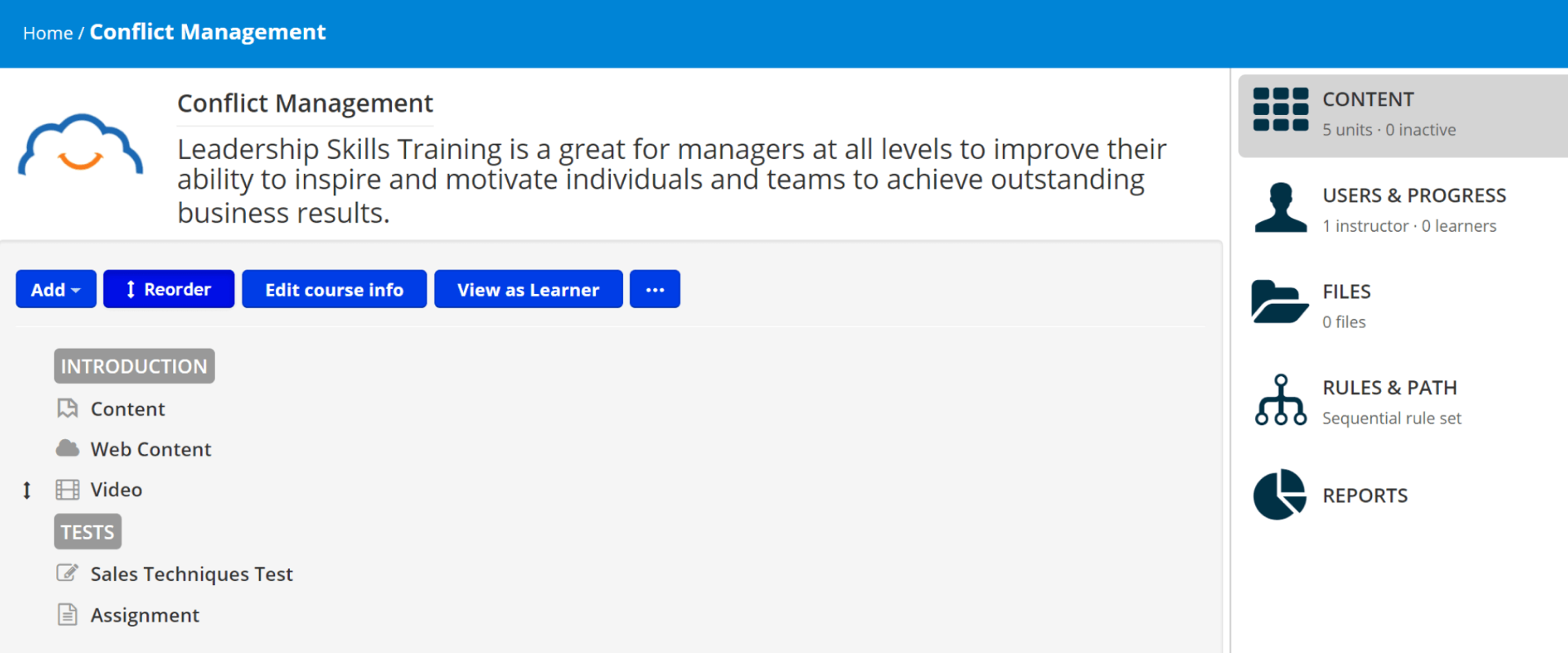
As a SCORM, xAPI, and cmi5-compliant LMS, TalentLMS supports easy course creation and progress tracking. Its SCORM reports provide valuable insights into learners’ performance, while its mobile compatibility ensures training on the go.
With seamless integration, gamification, and learning paths, TalentLMS offers a comprehensive solution trusted by top companies globally. Whether new to course creation or an experienced professional, you can build a smarter organization and deliver successful training experiences with the help of this platform.
Its easy-to-use course editor enables effortless course creation and customization. The platform’s adaptability, top-notch customer support, and positive customer reviews set it apart from its competitors, making it the go-to choice for organizations seeking to create a powerful workforce.
What You Will Like:
- Centralized location for all training manuals
- Section and module organization for structuring and organizing materials
- Quizzes for easy assessment and evaluation of learners’ understanding
- Integrates with HR software to streamline training and ensure data consistency
What You May Not Like:
- Certification management can be more efficient and user-friendly
- Reporting features need refinement, particularly filtering and data analytics
Pricing:
Starts at $69/month (billed yearly). Up to 40 users.
10. 360Learning – Best for Upskilling Employees
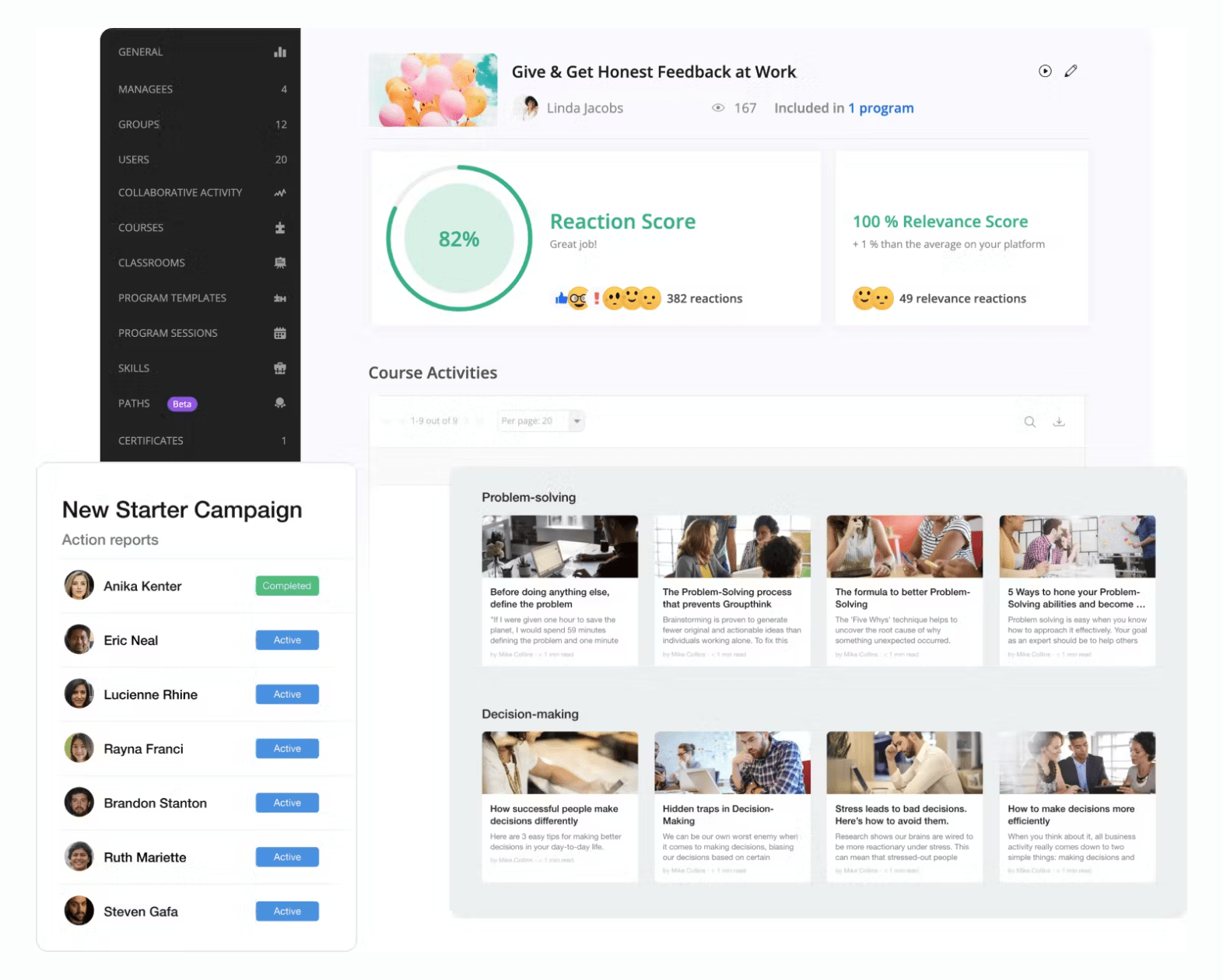
360Learning is a collaborative learning platform that aims to revolutionize corporate learning by promoting a collaborative learning culture. As one of the top SCORM LMS, it lets you embed existing SCORM modules.
Moreover, using 360Learning, L&D teams can measure the impact of SCORM courses over time. This platform supports various use cases like employee onboarding, compliance training, and more.
The tool addresses the shortcomings of traditional top-down learning methods and enables organizations to upskill from within and close skill gaps effectively. The platform boasts high learner engagement with a 91% course completion rate. It encourages learners to take ownership of their development.
With a focus on collaborative learning, organizations can crowdsource learning needs, identify subject-matter experts, and empower L&D teams to collaborate in course development.
Moreover, organizations can access resources such as eBooks, guides, and webinars to enhance their learning culture.
What You Will Like:
- Enables organizations to tap into their internal experts and knowledge
- The platform supports videos and multiple-choice questions on one page
- Provides data and analytics to track learner progress and engagement.
- The 24/7 online training academy provides instant help to users
What You May Not Like:
- There can be more gamification features to drive motivation and participation
- The search field requires improvement to provide users with more filtering options
Pricing:
Starts at $8/registered user/month. Up to 100 users.
After witnessing the impact of SCORM-compliant LMS on online learning and training, it’s safe to say that these solutions offer exceptional capabilities to streamline eLearning endeavors. With seamless integration and support for SCORM packages, they foster a versatile and engaging learning experience.
Which SCORM-Compliant LMS Should You Pick?
Selecting the right SCORM LMS depends on your specific requirements and preferences.
However, if you want expert advice, we can help you. Based on our experience, we have the following suggestions.
Option A: ProProfs Training Maker
ProProfs Training Maker is an excellent SCORM LMS due to its user-friendly interface, robust tracking capabilities, and diverse content authoring options. It suits businesses and educational institutions seeking an easy-to-use platform to deliver, track, and manage SCORM-compliant eLearning content effectively.
Option B: Docebo
You can consider Docebo if you need a powerful and seamless solution for managing eLearning content. With its automated SCORM compatibility, Docebo simplifies the delivery and tracking of SCORM courses, saving time and effort. It is an ideal option for organizations seeking a feature-rich platform that supports various content formats and provides a user-friendly experience for administrators and learners.
Option C: LearnUpon
For those on a tight budget, LearnUpon is a great option. This platform offers a cost-effective and scalable solution for small and medium-sized enterprises. LearnUpon’s extensive integration options and responsive customer support make it an ideal choice for efficiently delivering and managing SCORM-compliant eLearning content, enabling your organization to grow and thrive in the digital learning landscape.
The Future of SCORM
The creators of SCORM haven’t updated this eLearning standard in a while. But that doesn’t mean SCORM is dead. It’s still a vital part of the eLearning industry.
SCORM still serves training managers, instructors, and educators worldwide. According to Software Advice, 62% of businesses use SCORM courses for training in their LMS. It, thus, dominates the eLearning market.
The technology makes online courses more sustainable by enabling them to run on almost any LMS. But you’ll still need to create SCORM-compliant content. So, it’s too early to throw SCORM out the window.
The only thing we can expect is that it evolves with time, like xAPI and cmi5, to meet the new demands of online learning.
Ready for SCORM-Driven Learning?
You should be.
SCORM is now the must-have technical standard for all online learning environments. It’s already more than 20 years old and it has done an excellent job of being a pathbreaking force in the world of eLearning.
Despite gaining fast momentum, xAPI won’t be dethroning SCORM from its position as the preferred technical specification anytime soon. SCORM is still strongly embedded in the eLearning industry, and businesses and instructors will continue to depend on it.
Capitalize on this technological breakthrough and streamline how you conduct web-based training.
Adopt a SCORM LMS and easily deliver and track SCORM courses.
Frequently Asked Questions
What is a SCORM-compliant LMS?
It’s an LMS that adheres to the SCORM standard. It supports seamless integration and interoperability with SCORM content. It ensures that online courses and training modules created with SCORM standards can be delivered, tracked, and reported accurately across different platforms, providing a consistent learning experience.
Watch: What is a Cloud-Based Learning Management System?
What are the benefits of a SCORM LMS?
A SCORM LMS supports the seamless integration of standardized eLearning content and ensures consistent user experiences across different platforms. SCORM compliance enables accurate tracking of learner progress, completion, and performance, facilitating comprehensive reporting and analysis. This interoperability promotes cost-effectiveness, as organizations can easily reuse and share SCORM-compliant content. Additionally, SCORM compliance fosters greater flexibility in content development and delivery.
How do I choose a SCORM-compliant LMS?
Assess your training needs, ensure SCORM compatibility in the LMS, check user interface, and evaluate reporting and analytics features, scalability, and integration capabilities. Also, review customer support and security measures, and compare pricing and licensing options. Considering these factors, you can choose an LMS that aligns with your organization’s learning objectives.
Watch: How to Choose the Best LMS Software for Employee Training
Are all SCORM-compliant LMS the same?
While SCORM compliance ensures interoperability between LMS and SCORM content, it does not guarantee identical functionality or user experience. Different SCORM-compliant LMS may implement the standard in slightly different ways, leading to variations in how content is displayed, tracked, or reported. Additionally, these LMS may have varying features and capabilities beyond SCORM compliance, making them unique in overall performance and user interface.
What is a SCORM package?
A SCORM package is a collection of eLearning content and resources, such as HTML, multimedia files, assessments, and metadata, packaged together following the SCORM standard. The package is self-contained and can be uploaded and run on any SCORM LMS. SCORM packages facilitate easy sharing and distribution of content while ensuring compatibility and interoperability across different LMS platforms.
What is a SCORM wrapper?
A SCORM wrapper is like a digital table of contents that simplifies how learners navigate a course. The wrapper also enables an LMS to record learners’ interactions with content for easy reporting and compliance. Users can apply a SCORM wrapper to almost all types of training content and then upload it to an LMS.
Are there any alternatives to SCORM?
There are two main alternatives to SCORM. One is Tin Can API (a.k.a. Experience API or xAPI). xAPI can track learning experiences in nearly any context. This standard has recently gained some traction, but it’s not as widely used as SCORM. Another alternative is the Aviation Industry CBT (Computer-Based Training) Committee (AICC). This standard was developed for CD-ROM training and further improved in 1998 to include web-based learning.
Watch: What Is xAPI? Features and Benefits Explained
Do you want a free Training Software?
We have the #1 Online Training Software for employee training & assessment


